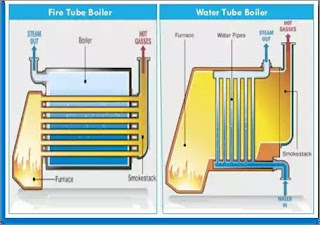S.No
|
Fire tube boiler
|
Water tube boiler
|
1
|
In Fire-tube boilers hot flue gases pass through tubes and water surrounds them.
|
In Water-tube boilers water passes through tubes and hot flue
gasses surround them.
|
2
|
These are operated at low pressures up to 20 bar.
|
The working pressure is high enough, up to 250 bar in super critical boilers.
|
3
|
The rate of steam generation and quality of steam are very low, therefore, not suitable for power generation.
|
The rate of steam generation and quality of steam are
better and suitable for power generation.
|
4
|
Load fluctuations cannot be handled.
|
Load fluctuations can be easily handled.
|
5
|
It requires more floor area for a given output.
|
It requires less floor area for a given output
|
6
|
These are bulky and difficult to transport.
|
These are light in weight, hence transportation is not a problem.
|
7
|
Overall efficiency is up to 75%.
|
Overall efficiency with an economizer is up to 90%.
|
8
|
Water doesn’t circulate in a definite direction.
|
Direction of water circulated is well defined.
|
9
|
The drum size is large and damage caused by bursting is large.
|
If any water tube is damaged, it can be easily replaced or repaired.
|
10
|
It requires more floor area for a given output.
|
It requires less floor area for a given output
|
11
|
Simple in design, easy to erect and low maintenance cost.
|
Complex, design, difficult to erect and high maintenance cost.
|
12
|
Even less skill operators are sufficient for efficient operation.
|
Skilled operators are required for operation.
|
13
|
The treatment of feed water is not very essential, as overheating due to scale formation cannot burst thick shell.
|
Treatment of feed water is very essential as small scale deposits inside
the tubes can cause overheating and bursting.
|
14
|
Used in process industry.
|
Used in large power plants.
|

















Comments
Post a Comment